Relationships between Physical, Mechanical and Acoustic Properties of Asphalt Mixtures Using Ultrasonic Testing
Abstract
:1. Introduction
| Material Property | Author | Ultrasonic Testing Description | Analytical Method | Findings/Contributions |
|---|---|---|---|---|
| Bulk Specific Gravity | Sztukiewicz [21] | Measure the propagation time/velocity of longitudinal ultrasonic wave at a constant frequency (500 kHz). | Build a linear relationship between the bulk specific gravity () and wave propagation velocity () as |
|
| Air Void Content | Zargar et al. [22] | Measure the ultrasonic velocity of compressive wave at a constant temperature (25 °C) and frequency (54 kHz). | Build a linear relationship between the air void content (AV) and ultrasonic velocity (UV) at the sample center as |
|
| Lame’s Constants [23] | Birgisson et al. [14] | Produce compression (P-wave) and shear (S-wave) ultrasonic waves and measure their velocities and . |
|
|
| Tigdemir et al. [24] |
| |||
| Norambuena-Contreras et al. [25] |
| |||
| Di Benedetto et al. [26] |
|
| ||
| Mounier et al. [27] |
| |||
| Larcher et al. [28] |
|
2. Material Selection and Sample Preparation
3. Laboratory Tests on Asphalt Mixtures
3.1. Physical Properties
3.2. Mechanical Properties
3.3. Acoustic Properties
4. Relationships between Acoustic, Physical and Mechanical Properties
4.1. Wave Velocity vs. Bulk Specific Gravity
4.2. Wave Velocity vs. Air Void Content
4.3. Wave Velocity vs. Dynamic Modulus
5. Conclusions and Future Work
- Linear function can describe the positive correlation between ultrasonic wave velocity and bulk specific gravity. The R2 of the fitting function ranges between 0.60–0.70. This correlation is negatively affected by the increase in the test frequency.
- Linear function can describe the negative correlation between ultrasonic wave velocity and air void content. The R2 of the fitting function ranges between 0.75–0.85.
- The dynamic modulus of asphalt mixtures can be predicted from a theoretical model for wave velocity in a linear isotropic viscoelastic material. With density, Poisson’s ratio, phase angle and ultrasonic wave velocity, a similar dynamic modulus can be obtained as from the laboratory dynamic modulus test.
Author Contributions
Funding
Institutional Review Board Statement
Informed Consent Statement
Data Availability Statement
Conflicts of Interest
References
- Wu, H.; Li, P.; Nian, T.; Zhang, G.; He, T.; Wei, X. Evaluation of asphalt and asphalt mixtures’ water stability method under multiple freeze-thaw cycles. Constr. Build. Mater. 2019, 228, 117089. [Google Scholar] [CrossRef]
- Deng, Y.; Luo, X.; Zhang, Y.; Cai, S.; Huang, K.; Shi, X.; Lytton, R.L. Determination of flexible pavement deterioration conditions using Long-Term Pavement Performance database and artificial intelligence-based finite element model updating. Struct. Control. Health Monit. 2021, 28, e2671. [Google Scholar] [CrossRef]
- Deng, Y.; Luo, X.; Wang, H. Backcalculation of damage density of in-service asphalt pavements using artificial intelligence-based finite element model updating. Fatigue Fract. Eng. Mater. Struct. 2022, 45, 671–686. [Google Scholar] [CrossRef]
- Hassan, N.A.; Airey, G.D.; Hainin, M.R. Characterisation of micro-structural damage in asphalt mixtures using image analysis. Constr. Build. Mater. 2014, 54, 27–38. [Google Scholar] [CrossRef]
- Deng, Y.; Luo, X.; Zhang, Y.; Lytton, R.L. Determination of complex modulus gradients of flexible pavements using falling weight deflectometer and artificial intelligence. Mater. Struct. 2020, 53, 1–17. [Google Scholar] [CrossRef]
- Moavenzadeh, F.; McMaster, R.C. Potential Uses of Sonic and Ultrasonic Devices in Highway Construction; The Ohio State University: Washington, DC, USA, 1966. [Google Scholar]
- George, B.; Arfken, D.F.; Griffing, D.C.; Kelly, J.P. Mechanical Waves; University Physics, Academic Press: Cambridge, MA, USA, 1984; pp. 344–360. [Google Scholar]
- McGovern, M.E.; Behnia, B.; Buttlar, W.G.; Reis, H. Use of nonlinear acoustic measurements for estimation of fracture performance of aged asphalt mixtures. Transp. Res. Rec. 2017, 2631, 11–19. [Google Scholar] [CrossRef]
- Qiu, X.; Xu, J.; Xiao, S.; Yang, Q. Acoustic emission parameters and waveforms characteristics of fracture failure process of asphalt mixtures. Constr. Build. Mater. 2019, 215, 135–147. [Google Scholar] [CrossRef]
- Qiu, X.; Xu, J.; Xu, W.; Xiao, S.; Wang, F.; Yuan, J. Characterization of fatigue damage mechanism of asphalt mixtures with acoustic emission. Constr. Build. Mater. 2020, 240, 117961. [Google Scholar] [CrossRef]
- Maillard, S.; de la Roche, C.; Hammoum, F.; Gaillet, L.; Such, C. Experimental investigation of fracture and healing at pseudo-contact of two aggregates. In Proceedings of the 3rd Euroasphalt and Eurobitume Congress, Vienna, Austria, 12–14 May 2004; Foundation Eurasphalt: Ermelo, The Netherlands, 2004. [Google Scholar]
- Chang, W. Application of Acoustic Emission to Study the Cohesive and Adhesive Strength of Asphalt; University of Southern California: Washington, DC, USA, 1994. [Google Scholar]
- Cheng, Y.; Zhang, P.; Jiao, Y.; Wang, Y.; Tao, J. Damage simulation and ultrasonic detection of asphalt mixture under the coupling effects of water-temperature-radiation. Adv. Mater. Sci. Eng. 2013, 2013, 838943. [Google Scholar] [CrossRef] [Green Version]
- Birgisson, B.; Roque, R.; Page, G.C. Ultrasonic pulse wave velocity test for monitoring changes in hot-mix asphalt mixture integrity from exposure to moisture. Transp. Res. Rec. 2003, 1832, 173–181. [Google Scholar] [CrossRef]
- Cui, X.; Zhang, J.; Zhang, N.; Zhou, Y.; Gao, Z.; Sui, W. Laboratory simulation tests of effect of mechanical damage on moisture damage evolution in hot-mix asphalt pavement. Int. J. Pavement Eng. 2015, 16, 699–709. [Google Scholar] [CrossRef]
- Dovom, H.A.; Moghaddam, A.M.; Karrabi, M.; Shahnavaz, B. Improving the resistance to moisture damage of cold mix asphalt modified by eco-friendly Microbial Carbonate Precipitation (MCP). Constr. Build. Mater. 2019, 213, 131–141. [Google Scholar] [CrossRef]
- Mallick, R.B.; Nivedya, M.; Veeraragavan, R.; Nazarian, S.; Tirado, C. An alternative approach to testing of moisture susceptibility of recycled pavement materials. J. Clean. Prod. 2019, 224, 583–591. [Google Scholar] [CrossRef]
- Pan, W.; Sun, X.; Wu, L.; Yang, K.; Tang, N. Damage Detection of Asphalt Concrete Using Piezo-Ultrasonic Wave Technology. Materials 2019, 12, 443. [Google Scholar] [CrossRef] [PubMed] [Green Version]
- Meng, A.; Xu, H.; Feng, X.; Tan, Y. Feasibility of freeze-thaw damage analysis for asphalt mixtures through dynamic nondestructive testing. Constr. Build. Mater. 2020, 233, 117220. [Google Scholar] [CrossRef]
- Sirin, O.; Ohiduzzaman, M.; Kassem, E.; Hassan, W. Acoustic Performance Evaluation of Dense-Graded Asphalt Pavements in Qatar. Adv. Civ. Eng. 2021, 2021, 5520432. [Google Scholar] [CrossRef]
- Sztukiewicz, R. Application of ultrasonic methods in asphalt concrete testing. Ultrasonics 1991, 29, 5–12. [Google Scholar] [CrossRef]
- Zargar, M.; Banerjee, S.; Bullen, F.; Ayers, R. An Investigation into the Use of Ultrasonic Wave Transmission Techniques to Evaluate Air Voids in Asphalt. In Global Civil Engineering Conference; Springer: Singapore, 2017; pp. 1427–1439. [Google Scholar]
- Sadd, M.H. Elasticity: Theory, Applications, and Numeric; Academic Press: Cambridge, MA, USA, 2009. [Google Scholar]
- Tigdemir, M.; Kalyoncuoglu, S.F.; Kalyoncuoglu, U.Y. Application of ultrasonic method in asphalt concrete testing for fatigue life estimation. NDT E Int. 2004, 37, 597–602. [Google Scholar] [CrossRef]
- Norambuena-Contreras, J.; Castro-Fresno, D.; Vega-Zamanillo, A.; Celaya, M.; Lombillo-Vozmediano, I. Dynamic modulus of asphalt mixture by ultrasonic direct test. NDT E Int. 2010, 43, 629–634. [Google Scholar] [CrossRef]
- Di Benedetto, H.; Sauzéat, C.; Sohm, J. Stiffness of bituminous mixtures using ultrasonic wave propagation. Road Mater. Pavement Des. 2009, 10, 789–814. [Google Scholar] [CrossRef]
- Mounier, D.; di Benedetto, H.; Sauzéat, C. Determination of bituminous mixtures linear properties using ultrasonic wave propagation. Constr. Build. Mater. 2012, 36, 638–647. [Google Scholar] [CrossRef]
- Larcher, N.; Takarli, M.; Angellier, N.; Petit, C.; Sebbah, H. Towards a viscoelastic mechanical characterization of asphalt materials by ultrasonic measurements. Mater. Struct. 2014, 48, 1377–1388. [Google Scholar] [CrossRef]
- Ministry of Communication of PR China. Technical Specification for Construction of Highway Asphalt Pavements; China Communication Press: Beijing, China, 2004. [Google Scholar]
- Ministry of Communication of PR China. Standard Test Methods of Bitumen and Bituminous Mixtures for Highway Engineering; China Communication Press: Beijing, China, 2011. [Google Scholar]
- ASTM D6925-15; Standard Test Method for Preparation and Determination of the Relative Density of Asphalt Mix Specimens by Means of the Superpave Gyratory Compactor. ASTM International: West Conshohocken, PA, USA, 2015.
- Speight, J.G. Test Methods for Aggregate and Asphalt Concrete. In Asphalt Materials Science and Technology; Speight, J.G., Ed.; Butterworth-Heinemann: Oxford, UK, 2016; Chapter 5; pp. 205–251. [Google Scholar]
- Deng, Y.; Zhang, Y.; Shi, X.; Hou, S.; Lytton, R.L. Stress–strain dependent rutting prediction models for multi-layer structures of asphalt mixtures. Int. J. Pavement Eng. 2021, 1–18. [Google Scholar] [CrossRef]
- American Association of State Highway and Transportation Officials. Standard Method of Test for Determining Dynamic Modulus of Hot Mix Asphalt (HMA); American Association of State Highway and Transportation Officials: Washington, DC, USA, 2011. [Google Scholar]
- Deng, Y.; Luo, X.; Gu, F.; Zhang, Y.; Lytton, R.L. 3D simulation of deflection basin of pavements under high-speed moving loads. Constr. Build. Mater. 2019, 226, 868–878. [Google Scholar] [CrossRef]
- Deng, Y.; Luo, X.; Zhang, Y.; Lytton, R.L. Evaluation of flexible pavement deterioration conditions using deflection profiles under moving loads. Transp. Geotech. 2021, 26, 100434. [Google Scholar] [CrossRef]
- Greenwood, M.S.; Bamberger, J.A. Measurement of viscosity and shear wave velocity of a liquid or slurry for on-line process control. Ultrasonics 2002, 39, 623–630. [Google Scholar] [CrossRef]
- Tiab, D.; Donaldson, E.C. Petrophysics: Theory and Practice of Measuring Reservoir Rock and Fluid Transport Properties, 4th ed.; Gulf Professional Publishing: Waltham, MA, USA, 2015. [Google Scholar]
- Devore, J.L. Probability and Statistics for Engineering and the Sciences, 8th ed.; Cengage Learning: Boston, MA, USA, 2011. [Google Scholar]
- Findley, W.N.; Lai, J.S.; Onaran, K.; Christensen, R. Creep and Relaxation of Nonlinear Viscoelastic Materials with an Introduction to Linear Viscoelasticity; North Holland Publishing Company: Amsterdam, The Netherlands, 1977. [Google Scholar]
- Zhang, Y.; Birgisson, B.; Lytton, R.L. Weak form equation–based finite-element modeling of viscoelastic asphalt mixtures. J. Mater. Civ. Eng. 2016, 28, 04015115. [Google Scholar] [CrossRef] [Green Version]
- Ling, M.; Deng, Y.; Zhang, Y.; Luo, X.; Lytton, R.L. Evaluation of complex Poisson’s ratio of aged asphalt field cores using direct tension test and finite element simulation. Constr. Build. Mater. 2020, 261, 120329. [Google Scholar] [CrossRef]

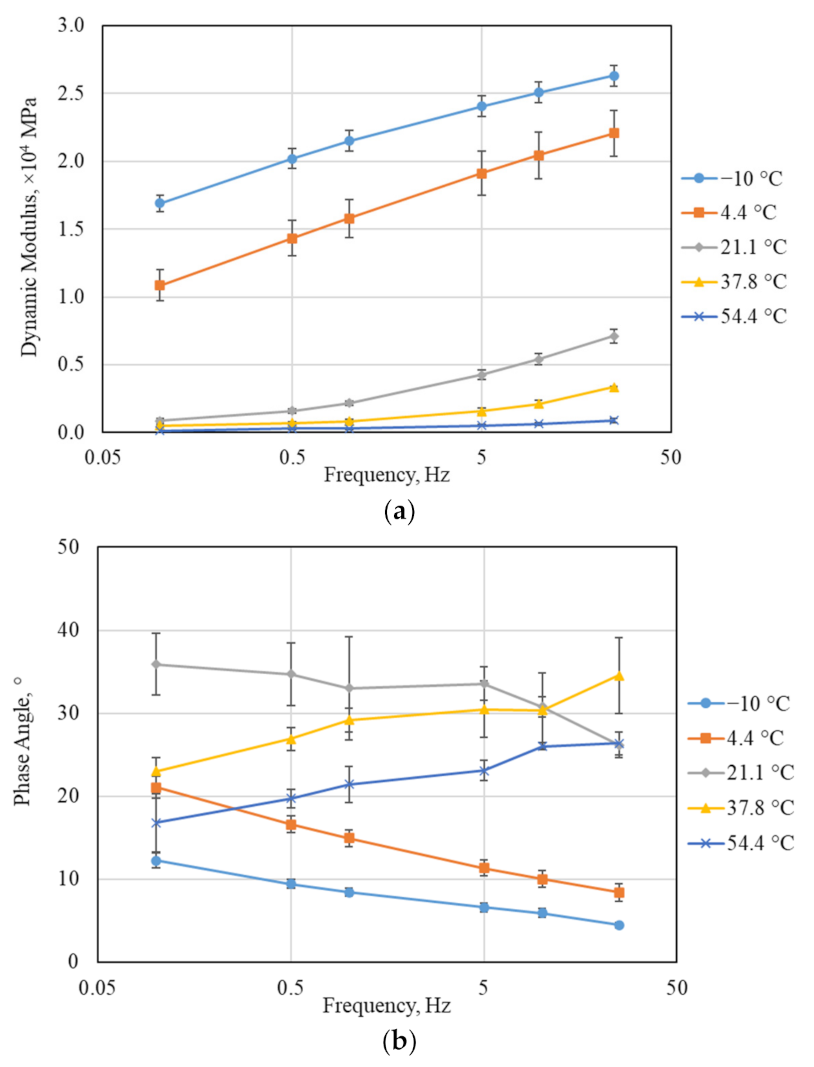
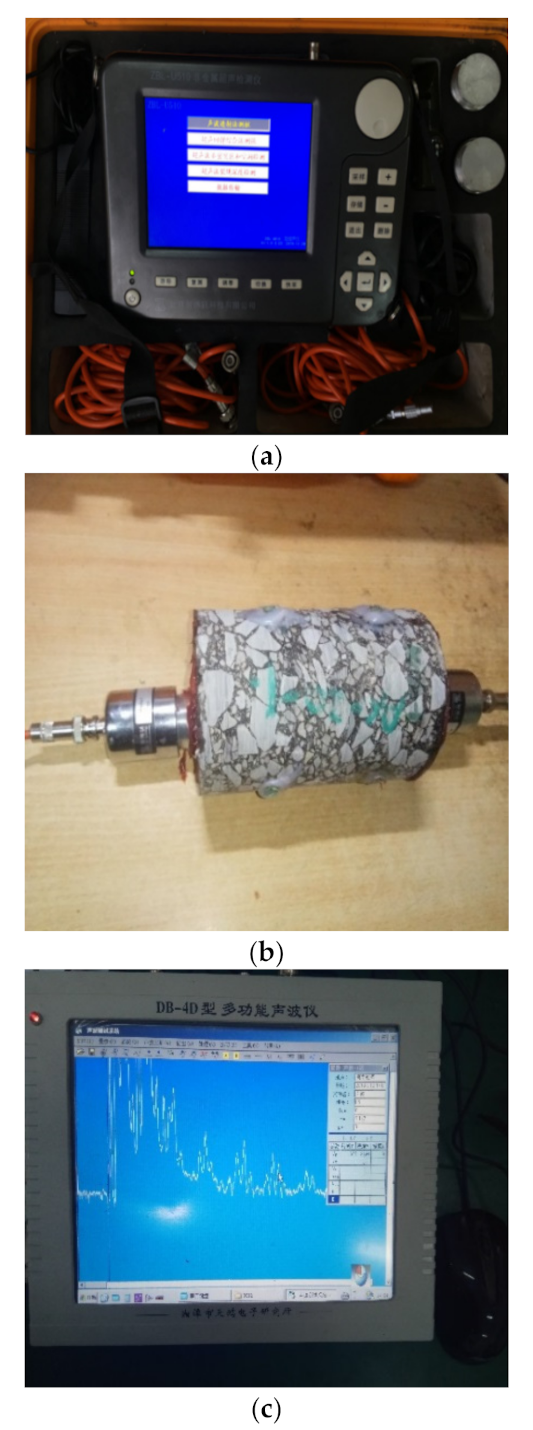
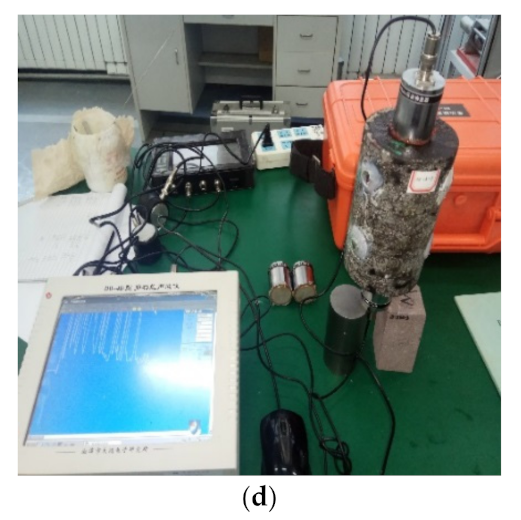
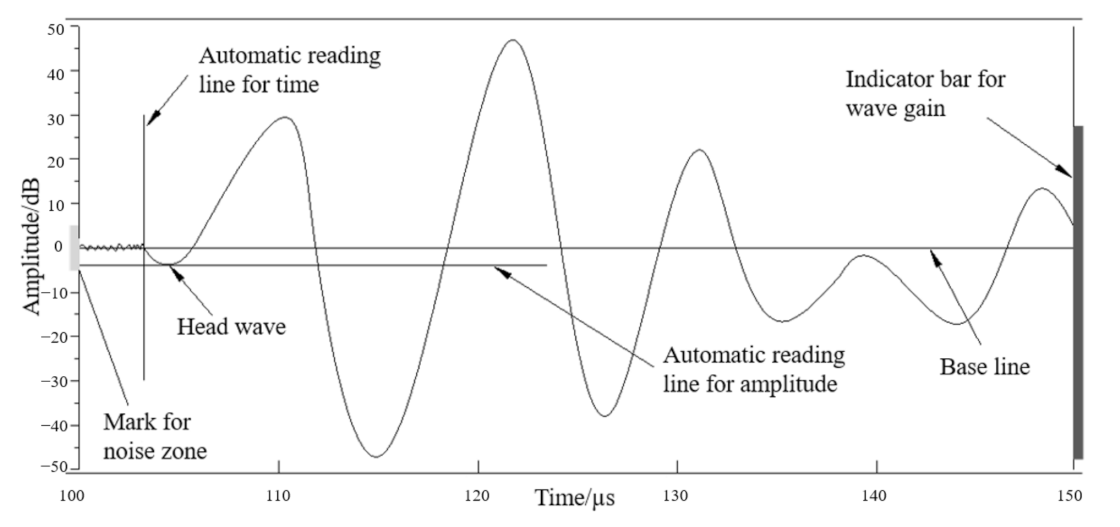

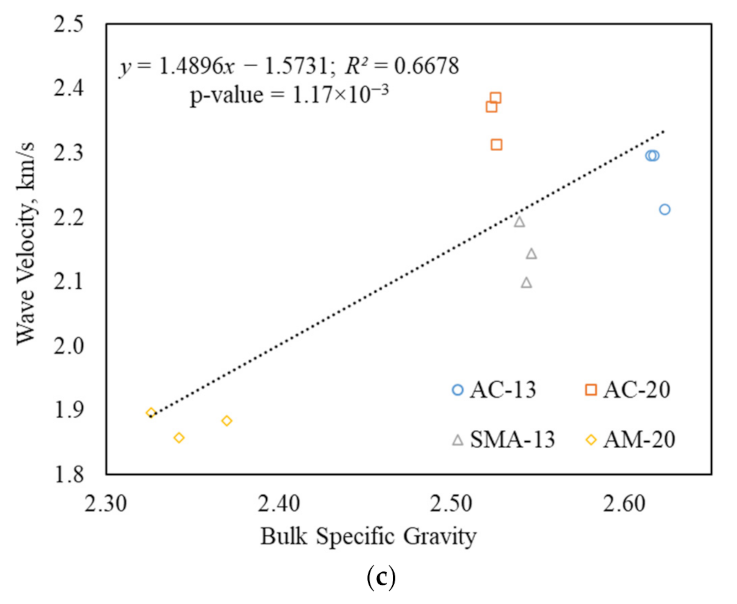
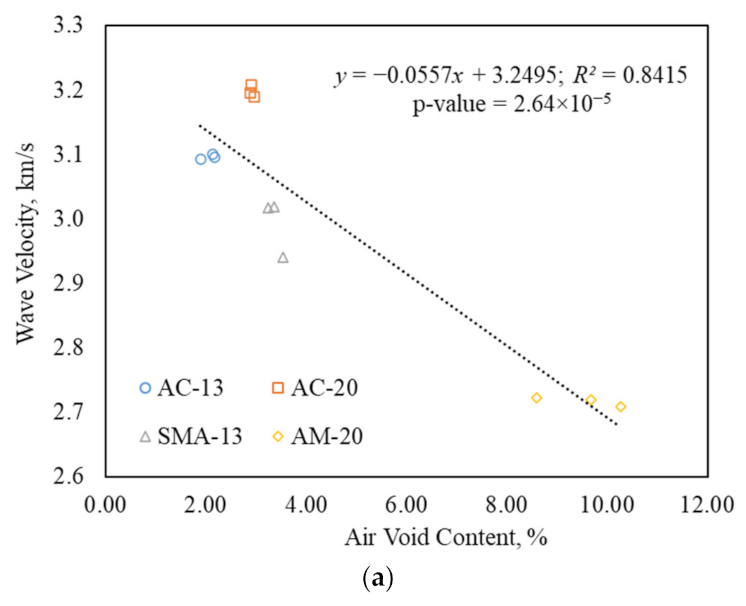

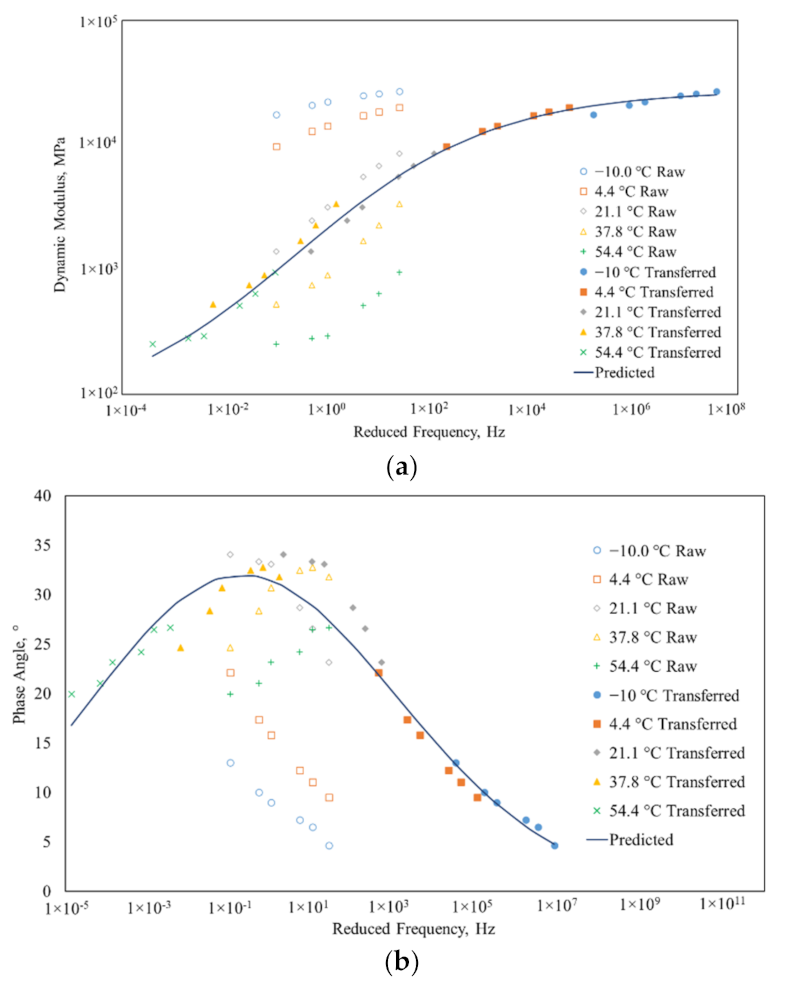

| Aggregates | Passing percentage of sieve size, % | 26.5 | 19.0 | 16.0 | 13.2 | 9.50 | 4.75 | 2.36 | 1.18 | 0.60 | 0.30 | 0.15 | 0.075 |
| AC-13 | 100 | 100 | 100 | 95 | 76.5 | 53 | 37 | 26.5 | 19 | 14 | 10 | 6 | |
| AC-20 | 100 | 95 | 83 | 72 | 61 | 41 | 30 | 22.5 | 16 | 11 | 8.5 | 5 | |
| SMA-13 | 100 | 100 | 100 | 95 | 62.5 | 27 | 20.5 | 19 | 16 | 13 | 12 | 10 | |
| AM-20 | 100 | 95 | 72.5 | 62.5 | 52.5 | 27.5 | 13.5 | 9 | 6.5 | 5 | 4 | 2.5 | |
| Asphalt binder | Penetration @ 25 °C, 100 g, 5 s (0.1 mm) | Softening point (°C) | Ductility @ 10 °C (cm) | Density @ 25 °C (g/cm3) | Flash point (°C) | Kinematic viscosity @ 135 °C (Pa·s) | |||||||
| 58 | 62 | 58.7 | 1.031 | 321 | 2.603 | ||||||||
| Gradation Type | Sample no. | Bulk Specific Gravity | Mean Value | Mean Value of Theoretical Maximum Specific Gravity | Void Ratio (%) | Mean Value (%) |
|---|---|---|---|---|---|---|
| AC-13 | 1 | 2.615 | 2.618 | 2.674 | 2.18 | 2.07 |
| 2 | 2.617 | 2.13 | ||||
| 3 | 2.623 | 1.90 | ||||
| AC-20 | 1 | 2.525 | 2.524 | 2.601 | 2.91 | 2.92 |
| 2 | 2.523 | 2.97 | ||||
| 3 | 2.526 | 2.88 | ||||
| SMA-13 | 1 | 2.543 | 2.543 | 2.632 | 3.36 | 3.38 |
| 2 | 2.546 | 3.25 | ||||
| 3 | 2.539 | 3.53 | ||||
| AM-20 | 1 | 2.326 | 2.346 | 2.593 | 10.27 | 9.52 |
| 2 | 2.342 | 9.68 | ||||
| 3 | 2.370 | 8.60 |
| Instrument Parameter | ZBL-U510 | DB-4D |
|---|---|---|
| (Maximum) Sampling length (Kb) | 0.512 | 32 |
| Sampling period (µs) | 0.4 | - |
| Sampling interval (µs) | - | 0.05 |
| Sampling frequency (MHz) | - | 20 |
| Transducer frequency (KHz) | 50 | 100 |
| Pulse width (µs) | 0.04 | 0.2 |
| Emission voltage (V) | 500 | 1000 |
| Number of channels | 2 | 4 |
| Testing temperature (℃) | 21.8 | |
| Sample Type | Ultrasonic Wave Test | P-Wave/S-Wave Test | ||||
|---|---|---|---|---|---|---|
| (µs) | (km/s) | (dB) | (KHz) | (km/s) | (km/s) | |
| AC-13 | 47.36 | 3.096 | 30.29 | 45.72 | 2.268 | 3.666 |
| SMA-13 | 49.27 | 2.992 | 26.60 | 43.03 | 2.146 | 3.536 |
| AC-20 | 45.86 | 3.197 | 29.62 | 44.82 | 1.990 | 3.812 |
| AM-20 | 53.74 | 2.711 | 27.47 | 44.19 | 1.879 | 3.245 |
| Property | Parameter | AC-13 | AC-20 | SMA-13 | AM-20 | ||||||||
|---|---|---|---|---|---|---|---|---|---|---|---|---|---|
| 1 | 2 | 3 | 1 | 2 | 3 | 1 | 2 | 3 | 1 | 2 | 3 | ||
| Dynamic modulus | 1.71 | 1.39 | 1.58 | 1.81 | 0.70 | 1.41 | 1.98 | 1.40 | 2.28 | 0.00 | 0.02 | 0.02 | |
| 2.82 | 3.16 | 2.89 | 2.62 | 3.72 | 3.03 | 2.35 | 2.99 | 1.99 | 4.29 | 4.27 | 4.19 | ||
| −0.35 | −0.33 | −0.47 | −0.31 | −0.42 | −0.34 | −0.34 | −0.34 | −0.32 | −0.47 | −0.48 | −0.47 | ||
| 0.57 | 0.48 | 0.62 | 0.52 | 0.53 | 0.52 | 0.59 | 0.50 | 0.72 | 0.47 | 0.53 | 0.50 | ||
| 1.34 × 10−3 | 1.18 × 10−3 | 1.14 × 10−3 | 1.31 × 10−3 | 1.35 × 10−3 | 1.18 × 10−3 | 1.40 × 10−3 | 1.13 × 10−3 | 2.04 × 10−3 | 7.82 × 10−3 | 1.06 × 10−3 | 1.32 × 10−3 | ||
| −0.91 | −0.83 | −0.79 | −0.90 | −0.92 | −0.83 | −0.95 | −0.79 | −1.35 | −0.58 | −0.73 | −0.91 | ||
| 152.86 | 141.33 | 133.26 | 153.83 | 155.77 | 142.21 | 157.16 | 135.67 | 219.89 | 104.07 | 123.90 | 156.30 | ||
| Phase angle | 35.56 | 33.60 | 22.05 | 31.96 | 31.40 | 29.72 | 29.42 | 30.26 | 30.15 | 45.77 | 36.44 | 37.66 | |
| 0.18 | 0.15 | 0.17 | 0.20 | 0.20 | 0.18 | 0.17 | 0.17 | 0.17 | 0.14 | 0.17 | 0.17 | ||
| 0.03 | 0.01 | 0.02 | 0.01 | 0.02 | 0.02 | 0.01 | 0.01 | 0.01 | 4.79 × 10−3 | 0.01 | 0.02 | ||
| 1.24 × 10−4 | −1.26 × 10−4 | 1.39 × 10−3 | −3.02 × 10−4 | −4.05 × 10−4 | −2.74 × 10−4 | −4.20 × 10−4 | −5.25 × 10−4 | 2.40 × 10−4 | −3.39 × 10−3 | 1.04 × 10−4 | 2.48 × 10−4 | ||
| −0.18 | −0.16 | −0.91 | 0.03 | 0.10 | 0.03 | 0.04 | 0.13 | −0.32 | 1.75 | −0.23 | −0.25 | ||
| 43.30 | 58.81 | 147.97 | 17.59 | 7.70 | 17.00 | 25.64 | 9.31 | 74.54 | −214.01 | 60.40 | 53.48 | ||
Publisher’s Note: MDPI stays neutral with regard to jurisdictional claims in published maps and institutional affiliations. |
© 2022 by the authors. Licensee MDPI, Basel, Switzerland. This article is an open access article distributed under the terms and conditions of the Creative Commons Attribution (CC BY) license (https://creativecommons.org/licenses/by/4.0/).
Share and Cite
Hou, S.; Deng, Y.; Jin, R.; Shi, X.; Luo, X. Relationships between Physical, Mechanical and Acoustic Properties of Asphalt Mixtures Using Ultrasonic Testing. Buildings 2022, 12, 306. https://doi.org/10.3390/buildings12030306
Hou S, Deng Y, Jin R, Shi X, Luo X. Relationships between Physical, Mechanical and Acoustic Properties of Asphalt Mixtures Using Ultrasonic Testing. Buildings. 2022; 12(3):306. https://doi.org/10.3390/buildings12030306
Chicago/Turabian StyleHou, Shuguang, Yong Deng, Rui Jin, Xijun Shi, and Xue Luo. 2022. "Relationships between Physical, Mechanical and Acoustic Properties of Asphalt Mixtures Using Ultrasonic Testing" Buildings 12, no. 3: 306. https://doi.org/10.3390/buildings12030306
APA StyleHou, S., Deng, Y., Jin, R., Shi, X., & Luo, X. (2022). Relationships between Physical, Mechanical and Acoustic Properties of Asphalt Mixtures Using Ultrasonic Testing. Buildings, 12(3), 306. https://doi.org/10.3390/buildings12030306






